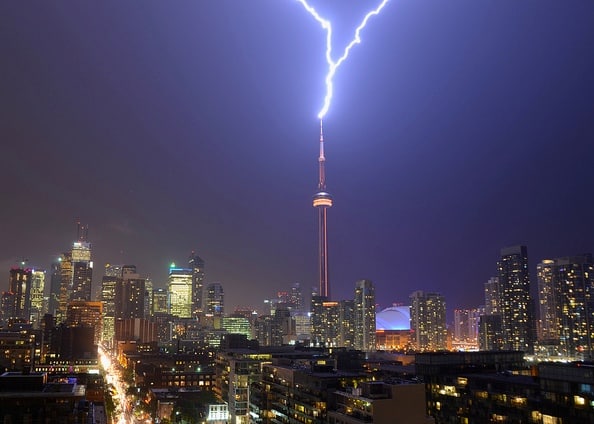

It could be considered a bit of an ungainly symbol for a country that prides itself on its rugged beauty; our lakes and forests and frozen ponds. Toronto’s CN Tower has been derided as an “an ugly hold over from the ” atomic ” age of the late 1960’s”, and an eyesore.
A then Toronto city alderman who was also an architect, Colin Vaughan, offered his opinion of the tower upon its opening in the mid-seventies, and he was not kind.
“The first disappointment comes at the main entrance. There’s no sensation of arriving at the base of a tall structure to be overwhelmed by the vision of the tower ahead. Instead you enter through a foyer boxed in with aluminum and glass shopping centre entrance doors. The foyer is roofed with an open truss, smeared with silver paint. Where is the tower? Who knows?…Undoubtedly the tower will draw millions of visitors who will come and gawk at the mechanical and electronic bric-a-brac and buy the CN tower–shaped rye bottles as souvenirs. But none will experience the unique sensation, the vertigo and the straight excitement which should accompany a visit to a structure of this scale.”
But since its opening day, on June 26, 1976, the CN Tower, which was the world’s tallest free-standing structure for 34 years until the near simultaneous completion of the Burj Khalifa and Canton Tower in 2010, continues to welcome hoards of visitors, who appreciate the recently added Edgewalk and don’t seem to mind the tacky souvenirs.
The CN Tower was born of necessity. Data communications in the late 1960’s and early 1970’s used point-to-point microwave links. Dish antennae transmitted data and covered the roofs of large buildings, but the signal became denigrated as new skyscrapers were added to the city’s burgeoning downtown core. The solution came from Canadian National Railway, who proposed the building of a large TV and radio communication platform to serve the Toronto area.
Construction on the tower began on February 6, 1973 and was completed in June, 1976, a torrid schedule by any measure, and one that no doubt left some Canadians feeling the landmark was hurried on the scene, and was perhaps an unwelcome neighbour. Those feelings have, for the most part faded, but the question of utility has not.
While the Burj Khalifa, upon its opening, commanded office space rents of (U.S.) $4,000 per square foot, a common question about the CN Tower from tourists is “What is it for?” As it turns out, apart from its original communications purposes and subsequent tourism, the tower has been a boon to the scientific community.
Lightning hits the CN Tower an average of 75 times per year, and it has thus become a sort of worldwide “lightning lab”. Metallic conductors connected to grounding rods run down the building’s side, enabling scientists to use it as a sort of giant surge protection experiment.
Wasyl Janischewskyj of the University of Toronto’ s Edward S. Rogers Sr. department of electrical and computer engineering says the CN Tower has been invaluable because its unique structure means the flow of electricity peaks in uncommon places. This allows researchers to examine less common patterns that may help protect sensitive electronic equipment.
And for weather geeks, the CN Tower is a mecca.
“The CN Tower is one of the best sites in the world to observe the lightning phenomenon at tall structures and to obtain definitive lightning data such as currents, resulting magnetic and electric fields, and the associated visual parameters,” noted a white paper from the North American Lightning Detection Network.
So is the CN Tower up there with insulin, the telephone and the light bulb as one of Canada’s greatest achievements? Absolutely not. But in a country that has recently seen a discernible uptick in national pride, the tower is a 1,135 ft foot reminder that we are not always polite and deferential and compliant. We were sometimes best, fastest, …highest.
Comment
One thought on “Where is the CN Tower on Canada’s list of achievements?”
Leave a Reply
You must be logged in to post a comment.




 Share
Share Tweet
Tweet Share
Share




I like it